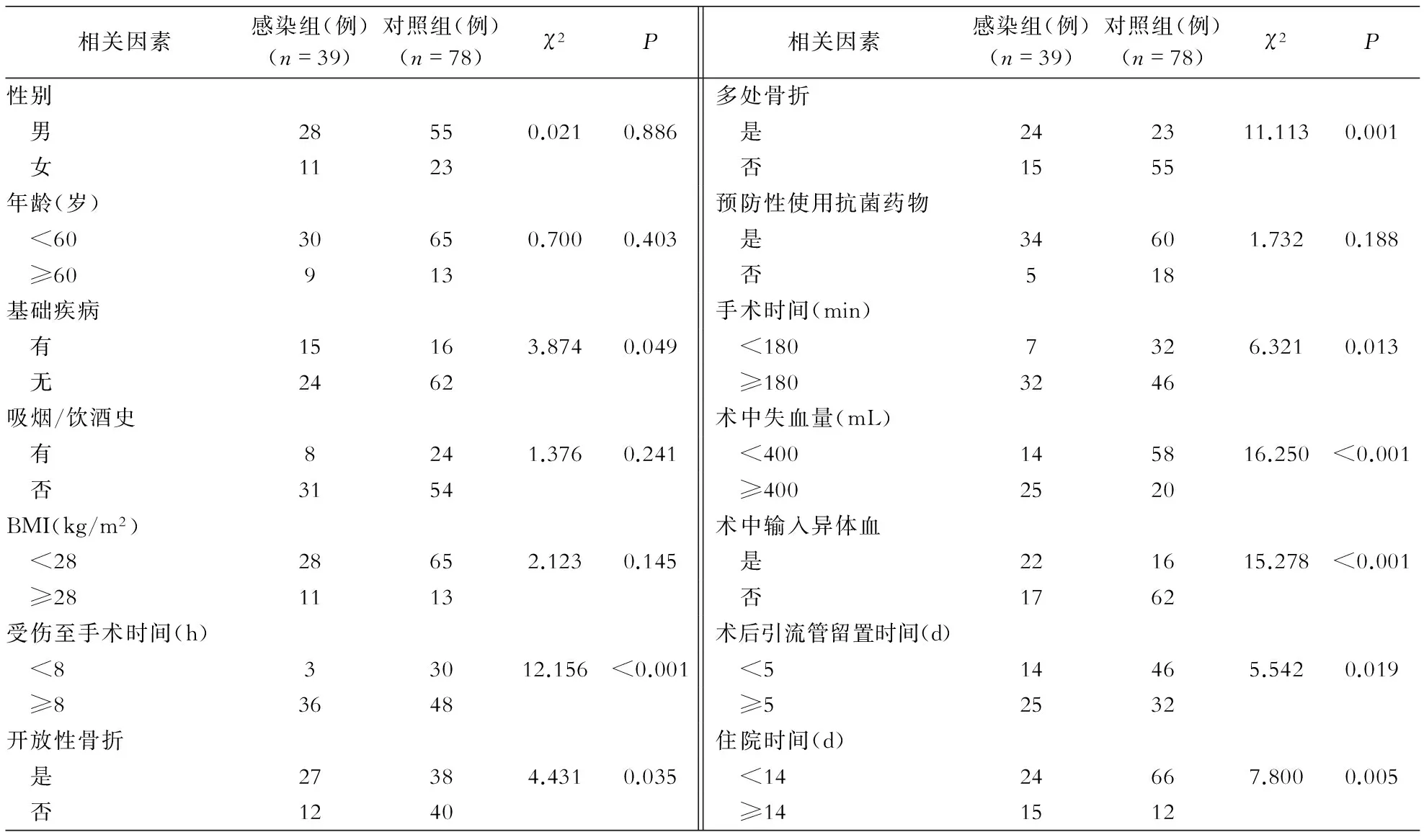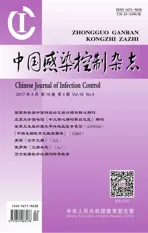四肢骨折内固定术后手术部位感染危险因素
2017-05-09桑宏勋吴子祥
白 博,桑宏勋 ,吴子祥,郇 科,苏 菲,刘 斌
(1 第四军医大学西京医院,陕西 西安 710032; 2 空军临潼航空医学鉴定训练中心,陕西 西安 710600; 3 南方医科大学深圳医院,广东 深圳 518000)
·论著·
四肢骨折内固定术后手术部位感染危险因素
白 博1,2,桑宏勋3,吴子祥1,郇 科1,苏 菲1,刘 斌1
(1 第四军医大学西京医院,陕西 西安 710032; 2 空军临潼航空医学鉴定训练中心,陕西 西安 710600; 3 南方医科大学深圳医院,广东 深圳 518000)
目的 了解四肢骨折患者内固定术后手术部位感染(SSI)的发病率和危险因素。方法 收集某院2013年1月—2016年1月收治的四肢骨折接受内固定手术治疗的患者资料,将术后发生SSI的39例患者纳入感染组,按1∶2的比例随机抽取同期术后未发生SSI的78例患者作为对照组,分析SSI的危险因素。结果 4 125 例骨折内固定患者术后SSI发生率为0.95%(39例),感染组细菌培养阳性率为87.2%(34/39),共分离病原菌38株,其中革兰阳性菌22株(57.9%),革兰阴性菌15株(39.5%),真菌1株(2.6%),金黄色葡萄球菌是主要致病菌(47.4%),多重耐药菌20株。单因素分析结果显示,合并基础疾病、受伤至手术时间≥8 h、开放性骨折、多处骨折、手术时间≥180 min、术中失血量≥400 mL、术中输入异体血、术后引流管留置时间≥5 d、平均住院时间≥14 d,感染组与对照组比较,差异有统计学意义(均P<0.05)。多因素logistic回归分析结果显示,受伤至手术时间≥8 h、开放性骨折、手术时间≥180 min、术后引流管留置时间≥5 d、住院时间≥14 d是骨折内固定术后SSI的危险因素(均P<0.05)。结论 四肢骨折内固定术后患者发生SSI的危险因素较多,减少危险因素,对降低SSI发生率,提高治愈率有积极作用。[关 键 词] 骨折; 内固定术; 手术部位感染; 术后感染; 危险因素
[Chin J Infect Control,2017,16(4):334-337]
近年来,随着生产生活中各种事故、车祸、自然灾害频发,导致骨折的患者日趋增多,内固定术是治疗骨折的最主要方法之一。由于抗菌药物耐药形势越来越严峻,术后手术部位感染(surgical site infection, SSI)发生率逐年增加。骨折内固定术后感染会延长住院时间,增加医疗费用,影响骨折愈合,给患者身心带来极大痛苦,应引起广泛重视[1-3]。骨折内固定术后感染受多种因素综合影响[4],临床诊断和治疗十分复杂,治疗效果大多不理想,常需行翻修手术,取出内固定,严重时可导致截肢,甚至危及生命[5-6]。明确内固定术后感染危险因素对预防感染,制定相应对策,降低术后感染发病率,缩短治疗周期有重要意义。本研究回顾性分析2013年1月—2016年1月第四军医大学西京医院骨科收治的四肢骨折接受内固定手术治疗术后发生SSI的患者资料,通过病例对照研究分析影响骨折内固定术后SSI的危险因素,以期为临床防治提供参考。
1 对象与方法
1.1 调查对象 2013年1月—2016年1月共有4 125例骨折患者在我院接受骨折切开复位内固定手术治疗,其中39例发生术后SSI(作为感染组),按照年龄、性别、主要诊断进行匹配,从同期同类手术患者数据库中按1∶2的比例随机选择78例术后未发生SSI的患者,作为对照组。
1.2 纳入与排除标准 纳入标准:(1)开放或闭合性四肢骨折患者,在本院行切开复位内固定手术治疗,病历资料完整,经实验室、影像学及微生物检查明确诊断为术后SSI的病例;(2)符合卫生部颁布的《外科手术部位感染预防与控制技术指南(2010年)》标准[7]。排除标准:(1)行外固定架、骨牵引、骨折清创术、截肢术及其他未行内固定术的患者;(2)术前骨折部位已经发生感染者;(3)术后切口脂肪液化的患者;(4)病历资料不完整的病例。
1.3 观察指标 收集感染组及对照组患者的资料,观察性别、年龄、体重指数(body mass index,BMI)、基础疾病(糖尿病、高血压、冠心病等)、吸烟饮酒史等指标。术前观察指标包括开放或者闭合性骨折、多处骨折、受伤时间等,术中观察指标包括手术时间、估计失血量、是否输异体血,术后观察引流管留置时间和住院时间。
1.4 统计学方法 应用SPSS 20.0统计软件进行数据统计分析,单因素分析采用χ2检验,多因素分析采用logistic回归分析,P≤0.05为差异有统计学意义。
2 结果
2.1 病原菌分布 4 215例骨折内固定患者术后SSI发生率为0.95%(39例),感染组细菌培养阳性率为87.2%(34/39)。34例细菌培养阳性患者共分离病原菌38株,其中革兰阳性球菌22株(57.9%),革兰阴性杆菌15株(39.5%),真菌1株(2.6%),两种或两种以上细菌混合感染者为10.3%(4/39);分离出其中多重耐药菌(multidrug-resistant organism,MDRO)20株。金黄色葡萄球菌18株,耐甲氧西林金黄色葡萄球菌(methicillin-resistantStaphylococcusaureus, MRSA)占77.8%(14/18),表皮葡萄球菌和粪肠球菌各2株;大肠埃希菌4株,其中产超广谱β-内酰胺酶(extended-spectrum β-lactamases, ESBLs)2株,铜绿假单胞菌和阴沟肠杆菌各4株。见表1。
表1 四肢骨折内固定术后SSI分离病原菌及构成比
Table 1 Species and constituent ratios of pathogens causing SSI after internal fixation surgery for limb fracture

病原菌株数构成比(%)革兰阳性菌2257.9 金黄色葡萄球菌1847.4 表皮葡萄球菌25.3 粪肠球菌25.3革兰阴性菌1539.5 大肠埃希菌410.5 铜绿假单胞菌410.5 阴沟肠杆菌410.5 鲍曼不动杆菌25.3 黏质沙雷菌12.6真菌12.6 近平滑假丝酵母菌12.6合计38100.0
2.2 SSI感染危险因素单因素分析 两组患者年龄、性别、体重指数及吸烟饮酒史、术前预防性使用抗菌药物,各组比较,差异均无统计学意义(均P>0.05)。感染组合并糖尿病、高血压、冠心病等基础疾病者占38.5%(15/39),对照组为20.5%(16/78),差异有统计学意义(P=0.049)。受伤至手术时间、开放性骨折、多处骨折、手术时间、术中失血量、术中输入异体血、术后引流管留置时间、住院时间感染组与对照组比较,差异均有统计学意义(均P<0.05)。见表2。
2.3 SSI危险因素的多因素分析 将单因素分析有统计学意义的9项指标纳入多因素logistic回归分析,结果显示,受伤至手术时间≥8 h、开放性骨折、手术时间≥180 min、术后引流管留置时间≥5 d、住院时间≥14 d是骨折内固定术后发生SSI感染的独立危险因素。见表3。

表2 四肢骨折内固定术后SSI危险因素单因素分析结果

表3 四肢骨折内固定术后SSI危险因素的logistic多因素分析结果
3 讨论
SSI是骨科术后常见的并发症之一,其发生率为0.4%~16.1%[8],开放性骨折术后感染发生率为1%~55%[9-11],骨折内固定术后感染受骨折类型、组织损伤程度及患者自身免疫状态及治疗方法等因素的综合影响[4, 12]。随着MDRO感染形势愈发严峻,其治疗难度越来越大,并给患者身心造成极大痛苦。由于骨科内固定术后SSI诊治的复杂性和重要性,本病已成为骨科医生近年来持续关注的热点。
骨折内固定术后SSI的致病菌主要为革兰阳性球菌,以金黄色葡萄球菌居多,与文献[13]报道结果基本一致。需要引起重视的是MDRO所占比率达52.6%,给治疗增加了难度,可能与创伤较重,伤口严重污染及抗菌药物滥用有关[14]。
本组骨折患者内固定术后SSI的发生率为0.95%。单因素分析结果表明,合并基础疾病、受伤至手术时间、开放性骨折、多处骨折、手术时间、术中出血量、输入异体血、术后引流管留置时间和住院时间≥4 d与骨科内固定术后SSI相关,与文献[2, 12]报道一致。多因素logistic回归分析结果显示,开放性骨折、受伤至手术时间≥8 h、手术时间≥180 min、术后引流管留置时间≥5 d和住院时间≥14 d是骨折内固定术后发生SSI的独立危险因素。开放性骨折导致人体皮肤、浅层软组织等组成的第一道免疫屏障被破坏,深层肌肉、骨组织暴露后易受到污染和细菌定植,增加感染风险[15]。受伤后6~8 h内彻底清创并进行骨折复位固定是治疗和预防开放性骨折最有效的方法,受伤至手术时间越长,病原菌污染、繁殖概率增加,感染风险进一步增大[16-17],早期、彻底清创可为促进骨折愈合提供良好生长环境。手术时间越久,手术器械、组织暴露在空气中受污染的概率越大,对骨折周围软组织牵拉时间增长,使其损伤加重,周围软组织更易出现缺血坏死,影响术后伤口愈合和康复效果。术后放置引流管的目的是将组织间隙的积血、积液引流至体外,降低伤口术后感染风险,促进创面愈合,但引流管留置时间过长会增加术后感染概率。受伤和手术的创伤均已不同程度降低了患者的免疫力,条件致病菌可导致感染的发生[18],住院时间增长,病房人员流动大,易发生交叉感染。
本研究为回顾性研究设计,存在一定的局限性:(1)单中心研究设计,样本量偏少,数据依靠病历记录。(2)骨折类型与术后感染关系密切,但由于样本量有限,未对骨折类型分类细化进行分析。(3)影响骨折内固定术后SSI的因素,如软组织损伤严重程度、术前蛋白水平、留置导尿时间等未进行统计分析。
总之,骨折内固定术后SSI的治疗十分棘手,对于需行切开复位内固定术的骨折患者,应从患者本身、手术及术后各个因素整体考虑,重视各种容易引起术后感染的危险因素,减少感染的发生。骨折内固定术后SSI与患者自身免疫力及外界因素密切相关,未来发展的方向应侧重对疾病的预防,最大限度地降低和减少外源性感染,重视危险因素在预测骨折内固定术后SSI的临床价值,做好防护工作,对降低发生率,减少患者疾病负担和心理负担,提高治愈率有积极作用。
[1] Edwards C, Counsell A, Boulton C, et al. Early infection after hip fracture surgery: risk factors, costs and outcome[J]. J Bone Joint Surg Br, 2008, 90(6): 770-777.
[2] Matos MA, Lima LG, de Oliveira LA et al. Predisposing factors for early infection in patients with open fractures and proposal for a risk score[J]. J Orthop Traumatol, 2015, 16(3): 195-201.
[3] 姜楠, 覃承诃, 余斌. 骨折内固定术后感染诊断与治疗的研究进展[J]. 中华创伤骨科杂志, 2015,17(9):764-769.
[4] Parkkinen M, Madanat R, Lindahl J, et al. Risk factors for deep infection following plate fixation of proximal tibial fractures[J]. J Bone Joint Surg Am, 2016, 98(15): 1292-1297.
[5] Mabit C, Marcheix PS, Mounier M, et al. Impact of a surgical site infection (SSI) surveillance program in orthopedics and traumatology[J]. Orthop Traumatol Surg Res, 2012, 98(6): 690-695.
[6] Willey M, Karam M. Impact of infection on fracture fixation[J]. Orthop Clin North Am, 2016, 47(2): 357-364.
[7] 中华人民共和国卫生部. 外科手术部位感染预防与控制技术指南[S].北京,2010.
[8] Zimmerli W. Clinical presentation and treatment of orthopaedic implant-associated infection[J]. J Intern Med, 2014, 276(2): 111-119.
[9] Hogan A, Heppert VG, Suda AJ. Osteomyelitis[J]. Arch Orthop Trauma Surg, 2013, 133(9): 1183-1196.
[10] Ojo OD, Oluwadiya KS, Ikem IC, et al. Superficial swab cultures in open fracture management: insights from a resource-poor setting[J]. J Wound Care, 2010, 19(10): 432-438.
[11] Trampuz A, Widmer AF. Infections associated with orthopedic implants[J]. Curr Opin Infect Dis, 2006, 19(4): 349-356.
[12] Greene LR. Guide to the elimination of orthopedic surgery surgical site infections: an executive summary of the Association for Professionals in Infection Control and Epidemiology elimination guide[J]. Am J Infect Control, 2012, 40(4): 384-386.
[13] Trampuz A, Zimmerli W. Diagnosis and treatment of infections associated with fracture-fixation devices[J]. Injury, 2006, 37(Suppl 2): S59-S66.
[14] Kardas P, Devine S, Golembesky A, et al. A systematic review and meta-analysis of misuse of antibiotic therapies in the community[J]. Int J Antimicrob Agents, 2005, 26(2): 106-113.
[15] Ivanov PA, Shibaev EU, Nevedrov AV, et al. Emergency soft tissue reconstruction algorithm in patients with open tibia fractures[J]. Open Orthop J, 2016 ,10: 364-374.
[16] Ashford RU, Mehta JA, Cripps R. Delayed presentation is no barrier to satisfactory outcome in the management of open tibial fractures[J]. Injury, 2004, 35(4): 411-416.
[17] Pollak AN, Jones AL, Castillo RC, et al. The relationship between time to surgical debridement and incidence of infection after open high-energy lower extremity trauma[J]. J Bone Joint Surg Am, 2010, 92(1): 7-15.
[18] Del Pozo JL, Patel R. Clinical practice. Infection associated with prosthetic joints [J]. N Engl J Med, 2009, 361(8): 787-794.
(本文编辑:付陈超)
Risk factors of surgical site infection in patients with internal fixation surgery for limb fracture
BAIBo1,2,SANGHong-xun3,WUZi-xiang1,HUANKe1,SUFei1,LIUBin1
(1XijingHospital,TheFourthMilitaryMedicalUniversity,Xi’an710032,China; 2LintongAviationMedicalEvaluatingandTrainingCenterofAirForce,Xi’an710600,China; 3ShenzhenHospital,SouthernMedicalUniversity,Shenzhen518000,China)
Objective To investigate the incidence and risk factors of surgical site infection(SSI) in patients with internal fixation surgery for limb fracture. Methods Medical data of patients with internal fixation surgery for limb fracture in a hospital from January 2013 to January 2016 were collected, 39 patients with SSI following internal fixation was as infection group, according to the 1:2 ratio, 78 patients without SSI following operation during the same period were randomly selected as the control group, risk factors of SSI were analyzed. Results Among 4 125 patients undergoing internal fixation surgery, incidence of SSI was 0.95% (n=39), the positive rate of bacterial culture in infection group was 87.2% (34/39), a total of 38 strains of pathogenic bacteria were isolated, among which 22 were gram-positive strains (57.9%), 15(39.5%)were gram-negative strains,1(2.6%) was fungi,Staphylococcusaureuswas the main pathogenic bacteria (47.4%), and there were 20 isolates of multidrug-resistant organisms. Univariate analysis showed that infection group and control group was significantly different in the following aspects: combined underlying diseases, time from injury to operation≥8 hours, open fracture, multiple fracture, duration of operation≥180 minutes, intra-operative blood loss≥400 mL, allogeneic blood transfusion, duration of postoperative indwelling drainage tube≥5 days, and average length of hospital stay≥14 days (allP<0.05). Multivariate logistic regression analysis showed that the following factors were risk factors for SSI following internal fixation surgery for fracture: time from injury to operation≥8 hours, open fracture, duration of operation≥180 minutes, duration of postoperative indwelling drainage tube≥5 days, and average length of hospital stay≥14 days (allP<0.05). Conclusion Risk factors for SSI in patients with internal fixation surgery for limb fracture are multiple, reducing risk factors has a positive effect on decreasing the incidence of SSI and improving the cure rate.
fracture; internal fixation surgery; surgical site infection; postoperative infection; risk factor
2016-10-17
国家自然科学基金资助项目(81270959)
白博(1987-),男(汉族),陕西省咸阳市人,硕士研究生,主要从事骨科感染研究。
桑宏勋 E-mail:hxsang@fmmu.edu.cn
10.3969/j.issn.1671-9638.2017.04.011
R181.3+2 R687.3
A
1671-9638(2017)04-0334-04
